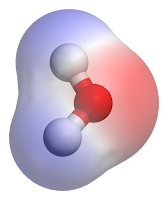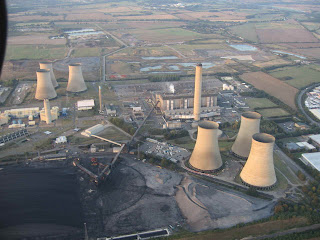- Why the "greenhouse effect" has to do with gases in the atmosphere,
- How these "greenhouse gases" in the atmosphere warm the Earth (and what that has to do with things that are "red hot"),
- What this implies for future warming as we put more of these gases into the atmosphere.
What Is The Greenhouse Effect?
The "greenhouse effect" refers to how gases in the atmosphere which absorb infrared radiation make the Earth warmer than it would be without them. (It has nothing to do with the way greenhouses work to protect plants by trapping warm air in an enclosure. That's just its name.)There are two ways to understand this phenomenon:
- Some gases in the atmosphere absorb infrared radiation emitted from the surface of the earth. This warms them up and they radiate energy, some of which heats the surface in turn.
- Gases in the atmosphere that absorb infrared radiation from the surface make the atmosphere more opaque to that radiation, preventing transmission from the surface into space. (Radiation into space still happens, but from high in the atmosphere where it is colder and thus radiates less.)
Over time the Earth reaches a temperature that radiates away as much energy as it receives from the Sun. But when the amount of greenhouse gases in the atmosphere change for some reason it takes time for the planet to warm or cool enough to restore that energy balance. That is why the "greenhouse effect" is in the news so much today--the concentrations of these greenhouse gases in the atmosphere are changing at unprecedented rates.
The Physics of the Greenhouse Effect
It is easy to understand the greenhouse effect if you comprehend these simple facts:- The Earth is a big warm rock
- Warm things emit radiation
- Other things absorb some of that radiation
- In particular the "greenhouse gases" in the atmosphere strongly absorb the infrared radiation the Earth emits
- When something absorbs radiation it heats up
- Warm things emit radiation (2. again)
- Other things absorb some of that radiation (3. again)
- Some of the radiation from the atmosphere (see 5.) is absorbed by the Earth, which warms it (see 4.)
- Some of the radiation from the atmosphere escapes into space, but less than if the atmosphere hadn't absorbed it on its way from the surface and sent some of it back down.
1. The Earth is a big warm rock. The average surface temperature is about 14.5 degrees C (287.5 degrees K). This is the near-surface atmospheric temperature (as would be measured by a thermometer at a weather station) averaged the seasons, over day and night, and over the geography of the earth. (See Wikipedia article Instrumental temperature record.) The Earth is warmed by radiation from the Sun that it absorbs, and by its own internal heat, some left over from its formation and some from radioactive decay of elements it is made from.
2. Warm things emit radiation. Any object radiates heat, in the form of electromagnetic radiation. Everybody is familiar with the idea of an object being "red hot". An object that hot emits enough light that we can see it, mostly in the infrared part of the spectrum but some at long visible wavelengths. When an object is "white hot" it emits even more radiation, including a lot of visible light and a substantial amount of ultraviolet radiation.
2a. The warmer a thing is the more radiation it emits. This is known as the Stefan–Boltzmann law. (See Wikipedia article Thermal radiation.)
You can easily demonstrate this. If you hold your hand near a toaster (not in a toaster!), where the radiation from the toaster's coils can hit it, the radiation from the toasters coils will be absorbed by your hand. Your skin will be warmed by this radiation, and the more radiation there is the more it will be warmed.
When the toaster is off and the coils are at room temperature you won't feel the warming of your skin. The nerves in your skin don't do much when they are just at room temperature.
(Everything that is not at a temperature of absolute zero emits radiation. But hotter things emit a lot more radiation than colder things. Notice that the Stefan-Boltzmann law says that the amount of energy radiated is proportional to the fourth power of the temperature: j*=εσT4. So coils glowing red hot--about 1,000 K--are hotter than coils at room temperature of about 293 K, about 700 degrees Kelvin hotter. They are three times as hot, but they emit more than 100 times as much radiation.)But when the toaster is on, and the coils are glowing red hot, they will emit a lot of infrared radiation (and a little visible radiation). Your hand would be warmed noticeably as it absorbed this greater quantity of radiation.
At 287.5 degrees Kelvin (14.5 degrees Celsius) most of the radiation the Earth emits is infrared radiation. None of it is in the visible range. (Even at 45 degrees Celsius, a really hot day, none none of the Earth's radiation is in the visible range. This is why the Earth does not appear to glow on a really hot night.)
3. The atmosphere absorbs radiation. Molecules of the gases that make up our atmosphere absorb radiation. Obviously the atmosphere doesn't absorb all wavelengths of radiation equally. It doesn't absorb much in the range of visible light (it is transparent to visible light). This is why we can see the Sun, Moon and stars. The oxygen and ozone in the atmosphere absorb a lot of ultraviolet radiation coming from the Sun. That is why organisms can live on the surface of the Earth (UV kills microorganisms and causes skin cancer in people, for example).
The atmosphere is mostly oxygen and nitrogen, but it is about 0.035% carbon dioxide. Carbon dioxide absorbs infrared radiation very strongly. Since the warm Earth emits mostly infrared radiation (with a peak at wavelengths of about 10-5 meters) and CO2 absorbs infrared radiation (especially that with a wavelength longer than about 1.3x10-5 meters) you can see that a lot of the infrared radiation from the surface of the Earth is absorbed by CO2 in the atmosphere. (The situation is similar for other "greenhouse gases" such as CFCs, nitrous oxide, methane and water vapor.) (See Greenhouse Gas Absorption Spectrum.)
4. When something absorbs radiation it heats up. The photons of radiation can interact with matter. How they interact depends on the properties of the photon (wavelength) and the properties of the atom or molecule of matter. (At the wavelengths we are talking about these properties mainly have to do with the energy states of its electrons.) When substances absorb radiative energy they increase their thermal energy. They get warmer.
2. again: Warm things emit radiation (see above). The warmer they are the more radiation they emit. The warmed greenhouse gases emit more infrared radiation than they did when it was cooler (see 2a. above). Some of that radiation escapes into space. Some is absorbed by other parts of the atmosphere. And some if it is absorbed by the Earth below, making it a little warmer (see 4. above).
So that's how the "greenhouse effect" works:
- Radiation from the Sun warms the Earth and the atmosphere
- The Earth emits infrared radiation (the warmer it is the more it emits)
- The "greenhouse gases" in the atmosphere, especially CO2, absorb some of that radiation from the earth, and this warms them up (the more of these gases there are the more they absorb)
- The warm gases in the atmosphere emit infrared radiation (and the warmer they are, and the more of them there are, the more they emit)
- Some of the infrared radiation from the "greenhouse gases" in the atmosphere is absorbed by the Earth, warming it a little more
- Loop back and repeat
The Net Result
The diagram below shows how all this works in terms of the Earth's energy balance.As you can see, the net imbalance (energy in minus energy out) is only 0.9 Watts per square meter. (Other estimates give net forcing of approximately 1 to 3 Watts per square meter.) Whatever the actual figure, it is enough to warm the Earth significantly over time.
Consequences
Also note that the net absorbed is only 0.26% of the total incoming energy flux. It only takes a small change in the transparency of the atmosphere in the infrared to change the outgoing long-wave (infrared) radiation enough to affect the surface temperature. And of course the more greenhouse gases in the atmosphere, the greater the climate forcing.How much will the Earth's temperature rise because of this 1 or 2 Watt per square meter forcing? That is the subject of urgent research. Current thinking is that the level of greenhouse gas in the atmosphere today, if we didn't put any more up there, might lead to a further increase in global temperature of one or two degrees Celsius or so.
But there are many difficulties with this estimate:
- Feedback effects. As the Earth warms up there will be changes in the global energy balance that might make it warm faster or slower, such as
- Melting of ice. Ice is highly reflective, so if it melts to expose bare ground or open sea less incoming solar radiation will be reflected back to space ("Reflected by Surface" in the diagram above).
- Vaporization of methane in permafrost and undersea deposits. Methane is one of the most significant greenhouse gases, and there are vast amounts of it tied up in frozen permafrost or in deposits of methane hydrates on the sea floor. If warming of the sea causes melting and release of some methane hydrates this could vastly decrease the transparency of the atmosphere to long-wave radiation, keeping more heat on the Earth. It is thought that when this happened in the geologic past it led to an earth many degrees hotter than today's.
- Warming seas. Cold water can absorb more carbon dioxide than warmer water. So as that 1 Watt per square meter radiative forcing warms the oceans, more carbon dioxide will be left in the atmosphere to act as a greenhouse gas.
- Clouds. As the climate warms the weather will change. There might be more clouds, or less, or their distribution might change. Clouds are an important part of the "Reflected by Clouds and Atmosphere" component of the energy budget in the diagram.
- Water vapor. Warmer air can hold more water vapor, and water vapor is a significant greenhouse gas.
- Continued emissions.
- We have already perturbed the planet's energy balance by putting around a trillion tonnes of greenhouse gases into the atmosphere over the past couple of centuries by burning fossil fuels and by land-use changes (burning forests). That is why the energy budget is out of balance by one or two Watts per square meter. But we continue to put about 35 billion additional tonnes of greenhouse gases into the air every year. And that annual emission figure continues to increase. So the concentration in the atmosphere will increase, the transparency of the atmosphere to infrared radiation will decrease, and the greenhouse climate forcing will increase. We are on course to put at least another trillion tonnes of greenhouse gases into the atmosphere by 2050, probably closer to two trillion.
The toaster image is from Explain that Stuff published under a Creative Commons License.
The energy balance diagram is from this UK government site, and is protected by Crown copyright. Used by permission.
Here is another explanation of the greenhouse effect.
David Wheat's Science In Action site has articles about science and math in the real world, weird science, science news, unexpected connections, and other cool science stuff. There is an index of the articles by topic here.
484TFZMUEH2N








